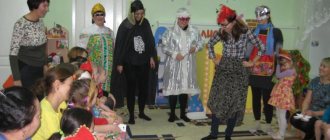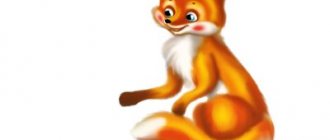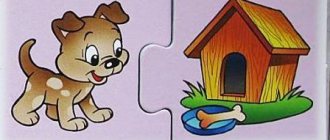Card index of games for the development of sound culture of speech (preparatory group)
Exercises to consolidate correct pronunciation and differentiation of sounds
Goals: to develop phonemic hearing, speech attention, to consolidate the correct pronunciation of sounds and words, to practice distinguishing between hard and soft consonants, voiced and voiceless consonants.
Game “Be Attentive” (in a circle with a ball)
The teacher invites the children to pass the ball around in a circle for each word, but if the word has the sound “sh”, throw the ball to him.
All children take part in the game. It is carried out at a fast pace. Exercise “Name the same syllables in words”
The teacher displays pictures on a flannelgraph: raspberries, a car. Educator. Listen to me slowly name the berry: maaliinaa, and now I will divide the word into pieces-syllables: ma-li-na. I will clap for each syllable, and you count how many syllables there are in the word. What is the first syllable, second syllable, third syllable? (Children's answers.)
Listen to how many syllables are in the word “car”: ma-shi-na (the teacher claps for each syllable). (Children's answers.)
What are the same syllables in the words “car” and “raspberry”? (“Ma”, “na”.)
The teacher displays pictures on a flannelgraph: boat, spoon.
Educator. These words have two syllables: boat, spoon. What are the same syllables in the words? (“Ka.”)
Game "Find your house"
Children are given object pictures. They offer to determine the first sound in the word name. One child is given a blue circle, the other a green circle. The teacher says that those whose first sound in the word is big brother (hard consonant) should go to the blue circle, and those whose word begins with a soft consonant sound (little brother) should go to the green circle.
At the signal “Find your house,” the players stand near the children with the corresponding mugs. The teacher checks the correct execution and determines the winning team.
Children change pictures and the game is repeated.
Exercise “Find a friend”
Pictures are displayed on the flannelgraph. First row: drum, flag, chicken, pipe, dog, cone; second row: parrot, wolf, goose, tram, umbrella, beetle.
Educator. Above and below the pictures. Let's arrange them in pairs so that the first sounds of the words are comrades (voiced-voiced sounds). Children go out, name the object and the first sounds of words. Place the lower pictures under the upper ones so that the first sounds form a “voiced-voiceless consonant” pair.
Game “Continue the word” (in a circle with a ball)
The teacher throws the ball to the child and pronounces the first syllable; the child names a word that begins with this syllable and throws the ball to the teacher. All children take part in the game.
An approximate list of syllables: “ma”, “ra”, “ry”, “le”, “re”, “zha”, “schu”, “cha”, “shu”, “si”, “za”.
All children take part in the game.
Game "Find a Pair"
Children are given one picture each.
Educator. Each of you has a picture. Think about what sound your word title begins with. At the “Find a pair” signal, you must find a picture in which the name of the object begins with the same sound.
The teacher checks the correctness of the task. Each pair of children names their objects and the sound with which the words denoting them begin.
The teacher marks the children who got into pairs earlier than everyone else.
Game “Name a Friend” (in a circle with a ball)
The teacher names a voiced consonant sound, and the children name its pair. When half of the children take part in the game, the task changes: the teacher names a deaf consonant, and the children name its pair.
Exercise “Where will the hammer hit? »
- In a word, only one sound is pronounced for a long time, as if it is being “hit” by a hammer: lunaaa (makes a sharp movement with his hand from top to bottom on the impact sound); vaaza (repeats the previous movement). The sound the hammer hits is called percussion (children repeat the word). In our words the stressed sound is “a”.
- You have pictures. You will name objects and find the stressed sound in words.
The pictures should be selected so that all vowels are stressed: rose, goat, boat, fish, scales, duck, fur coat, spider, turnip, nut, squirrel, watch, sleigh, fox, skis, bag, socks.
Game “Name the impact sound” (in a circle with a ball)
The teacher throws the ball, calls the word with emphasis on the stressed syllable; the child catches the ball, names the impact sound and throws the ball to the teacher.
Exercise “Guess the riddle”
The teacher puts pictures in a row: boat, duck, doll, bow (the last one with the reverse side).
Educator. What word will you get if you pronounce the first sounds of the name words and add them together? (Onion.)
The child not only names the word he received, but also explains how he composed it. After this, the teacher shows the guess word.
Another row is displayed: carrots, stork, chicken, poppy seeds (the latter with the reverse side). Children guess the word and explain how they did it.
Game "Say the word"
The teacher throws the ball to the child and names any consonant sound; the child must name the word that begins with this sound. All children take part in the game.
Exercise “Guess the riddle”
There are pictures in a row on the board: melon, wasps, car; To the side is an inverted picture - a house. Children guess the word based on the first sounds and explain how they did it. There are pictures in a row on the board: spoon, iron, sock, watermelon; To the side is an inverted picture of the moon. The task is the same.
Sound culture of speech. Preparing for literacy.
Transcript
1 Sound culture of speech. Preparing for literacy. Target. Continue to improve phonemic awareness and children’s ability to divide words into parts. Exercise children to determine the sequence of sounds in words. The teacher reminds the children that they are future schoolchildren already know and can do a lot: “For example, you know that a sentence consists of words, and you know how to name the words in the correct sequence. Even if it’s a big sentence, for example, like this: “The furry reins are explosive, the daring wagon is flying” (A. Pushkin “Winter! Peasant, triumphant”) What words can replace the word daring? (Dashing, fast-carrying me) Let’s say the sentence together to remember it.” Then the teacher “distributes” words to the children (Dime-Brazdy, Ole-Fluffy, etc.) and asks them to pronounce the phrase without stopping or skipping words. The teacher “distributes” the words to other children, and they also say the sentence. The third group of children builds a chain of words in the correct sequence at the teacher’s table. Next, the teacher asks the preschoolers to show (in any way) how many parts there are in the words winter, flies, run, tomato, and name these parts. “In the word run, the first part is be-,” says the teacher. Remember other words starting with the syllable be. (Hippopotamus, concrete, runner, trouble) And from the dictionary I wrote down these words: troubled, slacker, belek, blond, imp. Can you explain what these words mean? Today we will learn to determine the sequence of sounds in words,” explains the teacher. For example, the word poppy has three sounds: m, a, k. The word cat also has three sounds. Which? (cat). How many sounds are there in the word cats and what are these sounds? Name the sounds in the words cheese, cheeses.” At the end of the lesson, the teacher invites the children to play the game “I tell you, you give me.” During the game, children, when the teacher offers tasks, learn terms, sentences, parts of words, sounds, which is very important for their conscious use. Retelling of the fairy tale "The Fox and the Goat"
2 Purpose. To improve children's ability to retell a fairy tale in person. In life, people constantly have to tell something, the teacher tells the children, where they were, what they saw, what happened. Semicolon
3 Speech development Topic: Reading the fairy tale “The Snow Maiden” by V.V. Gerbova Purpose. Introduce children to a folk tale and the image of the Snow Maiden. Progress of the lesson “The New Year with Santa Claus, the Christmas tree and, of course, the Snow Maiden is long behind us,” the teacher begins the conversation. — There is ballet and opera about the Snow Maiden, and not a single New Year’s performance is complete without her. Today I will introduce you to a fairy tale called “The Snow Maiden”. The teacher reads a fairy tale and gives the children the opportunity to exchange impressions. Then he asks what the Snow Maiden looked like and whether she grew up quickly. After listening to the children’s answers, he reads: “And the old people’s daughter began to grow by leaps and bounds, every day she became more and more beautiful. She herself is as white as snow, her braid is brown to the waist, but there is no blush at all.” And he clarifies: “Did the old people have a good daughter?” (Smart, hard-working, intelligent, cheerful, loving.) At the end of the lesson, the teacher asks the children whether they liked the fairy tale. Topic: Writing a fairy tale about Cinderella. V. V. Gerbova Goal: To help children compose creative stories. “Do you like the fairy tale about Cinderella?” the teacher asks the children. “And I also like this fairy tale. But you must not know what preceded this tale. Long before the ball, the fairy of Evil appeared in the kingdom, who really, really wanted to marry her niece to the prince. But the prince had to fall in love with Cinderella. “This won’t happen! It’s not for nothing that I am the Fairy of Evil!” the sorceress decided. The Good Fairy, Cinderella's Godmother, was far away. She instructed the boy, who wanted to become a wizard, to protect and help Cinderella. The stepmother once again ordered Cinderella to clear a whole bag of buckwheat from garbage overnight. And only the girl got to work, like your versions, dear fairy tale writers.”
4 After one of the versions is accepted, the teacher hints at the Fairy’s next evil plan: “Cinderella ran for the berries, but instead of them she came across only fly agarics. And the stepmother won’t let the girl in the door without berries.” The children figure out what happened next. Then the teacher invites the children to fantasize about why Cinderella couldn’t sew hats for her stepmother’s daughters: for some reason the ribbons were torn and would not be tied. “Cinderella was so tired in the last days before the ball that she decided to find her father and tell him about her difficult life. She ran into the forest - Cinderella’s father was the royal forester, but” At the end of the lesson, the teacher asks the children if they liked composing the fairy tale. “But our fairy tale is not finished, since the Fairy of Evil has not yet left the kingdom. If you figure out how you managed to get rid of it, tell me.” Topic: Stories from pictures. V. V. Gerbova. Goal: to continue to improve children’s ability to compose stories from pictures with sequentially developing action. The teacher, using any set of demonstration pictures, invites the children to compose a story based on them. First, he asks you to arrange the pictures in a certain sequence and justify your decision. The teacher reminds that when composing a story, one should not skip pictures and that it is very important to come up with an introductory phrase-introduction to the topic. Next, the teacher gives the children pictures with the plot development of the action, intended for individual consideration (one set for two.) The children look at the pictures (the same pictures can be on 3-4 tables (photocopies.)). The teacher suggests how best to start the story: “One day this funny story happened” or “My pictures depict a very funny story”, etc.
5 Then one of the children talks about their pictures. The teacher asks who has the same picture and whether there will be additions to the peer’s story. Topic: Tales of H. H. Andersen (V. V. Gerbova) Purpose. Help children remember the fairy tales of H. H. Andersen they know. Preliminary work: Before class, children should read the fairy tales “Thumbelina”, “The Steadfast Tin Soldier”, “The Ugly Duckling”. The teacher reminds the children of the information they already know about H. H. Andersen: “Hans Christian Andersen was born in the small and very beautiful country of Denmark. He grew up in a poor family, and no one could have imagined that he would become a great storyteller. Anderson loved the theater, wanted to become an artist, but he did not turn out to be an artist. He began to write plays for the theater, and later came up with various funny stories that people really liked. He also loved to cut out wonderful human figures and ornaments from paper. Andersen's fairy tales are known to children all over the world. And you also know his tales. Which?" Children are called fairy tales. The teacher finds out which fairy tale they especially liked. If a fairy tale is named that was not read to the children in class, the teacher asks the child to tell its content. Helps if necessary. Next, the teacher reads excerpts from fairy tales of the children’s choosing.
The relevance of work on the sound culture of speech in the preparatory group
The demand for this topic is due to the importance of determining the basis for improving the culture of sound speech in preschool children. The reform of the educational program is also aimed at developing correct and clear speech in children.
Working on pronunciation
The emphasis is on the development of competent and harmonious speech components. Before learning to read, a child must master spoken language, learn to remember the correct phrases, and develop memory.
Preparing to Learn to Read
Stages:
- The first step is to teach children sounds, without going into exact formulations. Students must correctly pronounce sounds and find them in words, identify sounds both at the beginning/end of a word and in the middle.
- Introduce the concepts of “sound” and “words”. Reinforce with several practical exercises.
- It's easy to name words with a given sound.
- Give the concept of “offer”. Learn to break a word into syllables.
- Explain the difference between vowels and consonants.
- Divide sounds into voiced, voiceless, hard and soft.
- Description of the pictures. Compose short stories based on image data.
- Invite relatives to work together. Reading at home helps reinforce the skill.
- To get acquainted, create a stand for parents.
This approach allows you to prepare the child’s perception before conducting an open lesson in a preparatory group on speech development.
The child is developing speech
Preparation for sound analysis of words
It should be noted that problems with oral speech are closely related to written ones. Such children will have problems with writing texts in the future. Most often when working on an essay.
Important! It is worth adding the maximum number of synonyms to your child’s arsenal before learning to write. This will make his time at school much easier.
The sound culture of speech in the preparatory group takes place in the form of a game. With this presentation of material, children are ready to willingly complete tasks. Even the most active ones can be occupied and get good results (poems, fairy tales, tongue twisters). During the lessons, the teacher determines the individual characteristics of each student and focuses on overcoming the difficulties of phonetics.
Didactic games for the formation of grammatical structure of speech
The teacher must individually evaluate each student and determine ways to correct these defects. There are a great variety of modern techniques. For each case, you can choose a solution.
Preparing for school: general requirements
When transferred to school, the child must be able to read, count and speak correctly.
But that's not all, you should:
- Divide the word into syllables. Distinguish between vowels and consonants.
- Express yourself using the correct form of the word. It's easy to change a noun to an adjective, etc.
- Use simple and complex sentences.
- Describe the pictures in detail.
- Be able to retell the text.
- Write a story yourself.
- Master the pronunciation of all phonetic groups.
- Be able to distinguish and hear all sounds.
- Conduct sound-letter analysis.
Child composes a story
The first task is to divide the word into sounds. This is the first step in learning letters. In combination with didactic material, this makes it easier to understand. You can use pictures, like the alphabet, with simple and short words to start with.
For example, a picture of spring is suitable for several words. They name the word, divide it into syllables, and then into sounds.
The program has proven itself well. This is a hybrid of old domestic methods, originally from the Soviet Union, and new trends in the educational system. The teacher is faced with the task of teaching children clear and concise speech, with good diction.
Many come with all sorts of pronunciation problems. The modern system of communication in everyday life, unfortunately, does not promote correct speech. Children simply do not have enough positive examples at home.
Note! It is fashionable to talk incorrectly on TV - stylistically illiterate advertising, primitive and aggressively ubiquitous. All these factors influence children's attitudes towards language. The carriers of this cacophony are adults, often idols, who express thoughts in this way. This is a great reason to say the same. As a result, the percentage of children suffering from speech defects in preschool institutions, according to statistics, is 15%-20%.
Pupils often suffer from primitive vocabulary. They cannot coherently retell a cartoon or fairy tale that they have just listened to. Do not use adjectives, participles, or adverbs when speaking. First of all, it is necessary to address the vocabulary of such children. Convey to them the importance of developing rich speech, explain the benefits.
Exercises for speech development in children 2-3 years old
Important! Don't put all the work on the teacher. Involve parents, with whose support the material will be absorbed much better.





